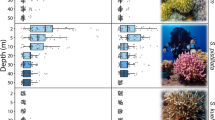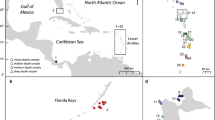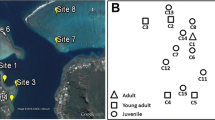Abstract
We investigate the relationship between habitat heterogeneity and morphological variation in the Caribbean coral species-complex, Madracis pharensis/decactis. This complex showed strong but incomplete morphospecies habitat-matching on a small spatial scale. We find that only one Madracis morphospecies dominates in environments consisting of either few vertical or few horizontal habitats, whereas in environments consisting of a mixture of horizontal and vertical habitats both morphospecies are common. We demonstrate that the observed patterns of morphospecies habitat-matching cannot be explained by a pure polyphenic model, where morphological variants are induced by a genotype-by-environment interaction at their settling site. Instead, we suggest that habitat-matching results in whole or in part from genetically predetermined factors. We present support for the hypothesis that this pattern of habitat-matching is due to habitat- and morphospecies-specific selective factors. Our study describes how a variable environmental factor, i.e. habitat distribution, has a non-linear effect on the spatial distribution of these morphospecies, thereby influencing the genetic organization of the Madracis coral complex at the ~+1–10 km spatial scale.
Similar content being viewed by others
References
Anthony KRN, Hoogenboom MO, Connolly SR. (2005) Adaptive variation in coral geometry and the optimization of internal colony light climates. Funct Ecol 19:17–26
Arnold MJ (1997) Natural hybridization and evolution. Oxford University press, Oxford, United Kingdom
Ayre DJ, Veron JEN, Dufty SL (1991) The corals Acropora palifera and Acropora cuneata are genetically and ecologically distinct. Coral Reefs 10:13–18
Ayre DJ, Hughes TP, Standish RS (1997) Genetic differentiation, reproductive mode, and gene flow in the brooding coral Pocillopora damicornis along the Great Barrier Reef, Australia. Mar Ecol Prog Ser 159:175–187
Baums IB, Miller MW, Hellberg ME (2005) Regionally isolated populations of an imperiled Caribbean coral, Acropora palmata. Mol Ecol 14:1377–1390
Bradshaw AD (1965) Evolutionary significance of phenotypic plasticity in plants. Adv Gen 13:115–155
Bruno JF, Edmunds PJ (1997) Clonal variation for phenotypic plasticity in the coral Madracis mirabilis. Ecology 78:2177–2190
Carlon DB, Budd AF (2002) Incipient speciation across a depth gradient in a scleractinian coral? Evolution 56:2227–2242
Diekmann OE, Bak RPM, Stam WT, Olsen JL (2001) Molecular genetic evidence for reticulate speciation in the coral genus Madracis from a Caribbean fringing reef slope. Mar Biol 139:221–233
Endler JA (1986) Natural selection in the wild. Princeton University Press, Princeton, NJ, USA
Endler JA (1973) Gene flow and population differentiation. Science 179:243–250
Edmunds PJ, Bruno JF, Carlon DB (2004) Effects of depth and microhabitat on growth and survivorship of juvenile corals in the Florida Keys. Mar Ecol Prog Ser 278:115–124
Ernande B, Dieckmann U (2004) The evolution of phenotypic plasticity in spatially structured environments: implications of intraspecific competition, plasticity costs and environmental characteristics. J Evol Biol 17:613-628
Fenner DP (1993) Species distinctions among several Caribbean stony corals. Bull Mar Sci 53:1099–1116
Fukami H, Budd AF, Levitan DR, Jara J, Kersanach R, Knowlton N (2004) Geographic differences in species boundaries among members of the Montastraea annularis complex based on molecular and morphological markers. Evolution 58:324–337
Graus RR, Macintyre IG (1982) Variation in growth forms of the reef coral Montastrea annularis (Ellis and Solander): a quantitative evaluation of growth response to light distribution using computer simulation. In: Rutzlere K, Macintyre IG (eds) The Atlantic barrier reef ecosystem at Carrie Bow Cay, Beliz. Smith. Inst. Press, Washington, USA, pp 441–465
Hatta M, Fukami H, Wang WQ, Omori M, Shimoike K, Hayashibara T, Ina Y, Sugiyama T (1999) Reproductive and genetic evidence for a reticulate evolutionary history of mass-spawning corals. Mol Biol Evol 16:1607–1613
Hedrick PW, (1986) Genetic polymorphism in heterogeneous environments: a decade later. Ann Rev Ecol Syst 17:535–566
Hedrick PW, Ginevan ME, Ewing EP (1976) Genetic polymorphism in heterogeneous environments. Ann Rev Ecol Syst 7:1–36
Hilborn R, Mangel M (1997) The ecological detective: confronting models with data. Princeton University Press, New Jersey, USA
Karlin S, McGregor JB (1972) Polymorphisms for genetic and ecological systems with weak coupling. Theor Pop Biol 3:210–238
Kimura M (1983) The neutral theory of molecular evolution. Cambridge University Press, Cambridge, UK
Knowlton N, Mate JL, Guzman HM, Rowan RJ, Jara J (1997) Direct evidence for reproductive isolation among the three species of the Montastraea annularis complex in Central America (Panama and Honduras). Mar Bio1 127:705–711
Lasker HR, Brazeau DA, Calderon J, Coffroth MA, Coma R, Kim K (1996) In situ rates of fertilization among broadcast spawning gorgonian corals. Biol Bull 190:45–55
Levins R (1963) Theory of fitness in a heterogeneous environment. II Developmental flexibility and niche selection. Am Nat 47:75–90
Levins R (1968) Evolution in changing environments. Princeton University Press, Princeton
Levitan DR, Fukami H, Jara J, Kline D, McGovern TM, McGhee KE, Swanson CA, Knowlton N (2004) Mechanisms of reproductive isolation among sympatric broadcast-spawning corals of the Montastraea annularis species complex. Evolution 58:308–325
Magalon H, Adjeroud M, Veuille M (2003) Patterns of genetic variation do not correlate with geographical distance in the reef-building coral Pocillopora meandrina in the South Pacific. Mol Ecol 14:1861–1868
Marquez LM, Van Oppen MJH, Willis BL, Reyes A, Miller DJ (2002) The highly cross-fertile, Acropora hyacinthus and Acropora cytherea, constitute statistically distinguishable lineages. Mol Ecol 11:1339–1349
McCormick MI (1994) Comparison of field methods for measuring surface topography and their associations with a tropical reef fish assemblage. Mar Ecol Prog Ser 112:87–96
McKinnon JS, Mori S, Blackman BK, David L, Kingsley DM, Jamieson L, Chou J, Schluter D (2004) Evidence for ecology’s role in speciation. Nature 429:294–298
Miller KJ (1994) Morphological variation in the coral genus Platygyra: environmental influences and taxonomic implications. Mar Ecol Prog Ser 110:19–28
Moran NA (1992) The evolutionary maintenance of alternative phenotypes. Am Nat 139:971–989
Muko S, Kawasaki K, Sakai K, Takasu F, Shigesada N (2000) Morphological plasticity in the coral Porites sillimaniani and its adaptive significance. Bull Mar Sci 66:225–239
Nagelkerken I, Bak RPM (1998) Differential regeneration of artificial lesions among sympatric morphs of the Caribbean corals Porites astreoides and Stephanocoenia michelinii. Mar Ecol Prog Ser 163:279–283
Odorico DM, Miller DJ (1997) Variation in the ribosomal internal transcribed spacers and 5.8 S rDNA among five species of Acropora (Cnidaria; Scleractinia) patterns of variation consistent with reticulate evolution. Mol Biol Evol 14:465–473
Schmalhausen II (1949) Factors of evolution: the theory of stabilizing selection. Blakiston, Pennsylvania, USA
Sotka EE, Wares JP, Barth JA, Grosberg RK, Palumbi SR (2004) Strong genetic clines and geographical variation in gene flow in the rocky intertidal barnacle Balanus glandula. Mol Ecol 13:2143–2156
Szmant AM, Weil E, Miller MW, Colon DE (1997) Hybridization within the species complex of the scleractinian coral Montastraea annularis. Mar Biol 129:561–572
Udovic D (1980) Frequency-dependent selection, disruptive selection, and the evolution of reproductive isolation. Am Nat 116:621–641
Van Duyl FC (1985) Atlas of the living reefs of Curaçao and Bonaire, Netherlands Antilles. Publ Found Sci Res Surinam The Netherlands Antilles 117:1–38
Van Moorsel GWNM (1988) Early maximum growth of stony corals (Scleractinian) after settlement on artificial substrata on a Caribbean reef. Mar Ecol Prog Ser 50:127–135
Van Veghel MLJ, Bak RPM (1993) Intraspecific variation of a dominant Caribbean reef coral, Montastraea annularis: genetic, behavioral and morphometric aspects. Mar Ecol Prog Ser 92:255–265
Van Veghel MLJ, Bak RPM (1994) Reproductive characteristics of the polymorphic Caribbean reef building coral Montastraea annularis. 3: reproduction in damaged and regenerating colonies. Mar Ecol Prog Ser 109:229–233
Vermeij MJA (2002) The evolutionary ecology of the Caribbean coral genus Madracis. PhD-thesis, University of Amsterdam, Amsterdam, The Netherlands
Vermeij MJA (2005) Substrate characteristics and adult density determine recruitment patterns in a Caribbean brooding coral. Mar Ecol Prog Ser 295:123–133
Vermeij MJA (2006) Early life-history dynamics of Caribbean coral species on artificial substratum: the importance of competition, growth and variation in life-history strategy. Coral Reefs 25:59–71
Vermeij MJA, Bak RPM (2002) How are coral populations structured by light? Marine light regimes and the distribution of Madracis. Mar Ecol Prog Ser 233:105–116
Vermeij MJA, Bak RPM (2003) Species-specific population structure of closely related coral morphospecies along a depth gradient (5–60 m) over a Caribbean reef slope. Bull Mar Sci 73:725–744
Vermeij MJA, Sampayo EM, Bröker K, Bak RPM (2003) Variation in planulae release of closely related coral species. Mar Ecol Prog Ser 247:75–84
Vermeij MJA, Sampayo EM, Bröker K, Bak RPM (2004) Gametogenesis in the Caribbean genus Madracis. Coral Reefs 23:206–214
Vermeij MJA, SA Sandin (in press) Coral species complexes through space and time: an illustration of their dynamics using the Caribbean genus Madracis. Proc. 10th Int. Coral Reef Symp
Veron JEN (1995) Corals in space and time. Cornell University Press, Ithaca, Pennsylvania, USA
Vollmer SV, Palumbi SR (2002) Hybridization and the evolution of reef coral diversity. Science 296:2023–2025
Willis BL, Babcock RC, Harrison PL, Wallace CC (1997) Hybridization and breeding incompatibilities within the mating systems of mass spawning reef corals. Proc 8th Int Coral Reef Symp 1:81–90
Acknowledgements
We thank the following people for assistance in the field: S. “Henano’’ Hamilton, Bryce Anderson, N. Johansen, E. Sampayo, A. Engelen, A. “Wrasse’’ Rassweiler and S. Gladding. The Carmabi Foundation provided logistical support. J. Dushoff, J. Regetz, M. Hellberg, M. van Oppen, R. Bak, L. Spinney, J. Wilder and I. Baums are thanked for their assistance during various stages of this project. Comments by M. Dijksman and two anonymous reviewers greatly helped us to improve an earlier version of our ms. We are grateful to the Royal Dutch Academy of Sciences (KNAW) for financial support to MJAV. This is Dweezendputen contribution 1-A.
Author information
Authors and Affiliations
Corresponding author
Additional information
The order of authors was determined by a swim competition around the island of Klein Curaçao on June 20, 2001
Rights and permissions
About this article
Cite this article
Vermeij, M.J.A., Sandin, S.A. & Samhouri, J.F. Local habitat distribution determines the relative frequency and interbreeding potential for two Caribbean coral morphospecies. Evol Ecol 21, 27–47 (2007). https://doi.org/10.1007/s10682-006-9122-z
Published:
Issue Date:
DOI: https://doi.org/10.1007/s10682-006-9122-z




